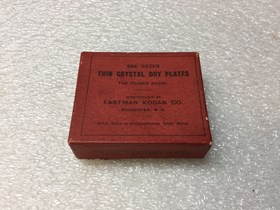Narrow Results By
- Date
- 1920 – 1940
- Material
- cardboard; paper; glass;
- Catalogue Number
- 104.41.0220
- Description
- Box of one dozen Thin Crystal Dry Plates for a Pocket Kodak camera. The box’s seal has been broken - inside are alternating layers of thin black paper and the glass plates, which are fogged.Dry plate, or the gelatin process, was invented by Dr. Richard L. Maddox in 1871 and replaced the more time-c…
1 image
- Title
- Dry Plates
- Date
- 1920 – 1940
- Material
- cardboard; paper; glass;
- Dimensions
- 1.9 x 6.0 x 5.1 cm
- Description
- Box of one dozen Thin Crystal Dry Plates for a Pocket Kodak camera. The box’s seal has been broken - inside are alternating layers of thin black paper and the glass plates, which are fogged.Dry plate, or the gelatin process, was invented by Dr. Richard L. Maddox in 1871 and replaced the more time-consuming wet plate, or collodion process, which required active wet chemicals to be prepared in mobile dark rooms. The dry plate process underwent several adaptations throughout the 1870s and, in 1879, George Eastman developed a method of applying the emulsion layer to glass in a factory setting, simultaneously creating what came to be known as the Eastman Kodak Co. and bringing down the cost of photography so as to be accessible to the masses.
- Subject
- photography
- photographic equipment
- Credit
- Gift of Catharine Robb Whyte, O. C., Banff, 1979
- Catalogue Number
- 104.41.0220
Images
This material is presented as originally created; it may contain outdated cultural descriptions and
potentially offensive content.
Read more.


